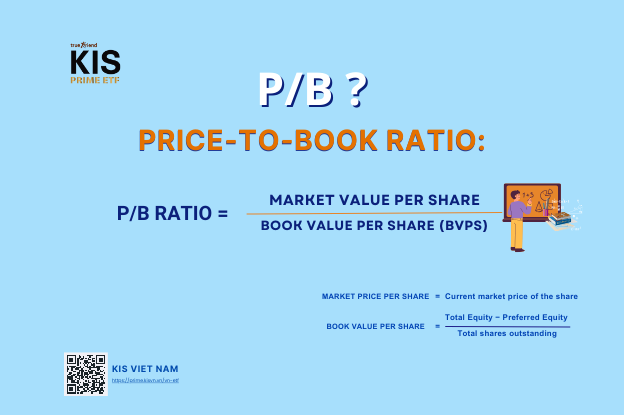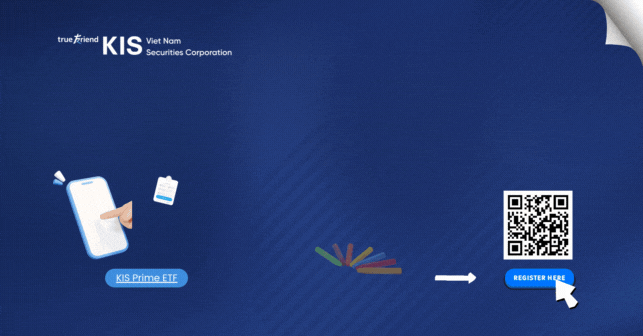ETF Dictionary
What is Price-to-Book (PB) Ratio ?
Understanding Price to Book PB Ratio – A Beginner’s Guide to Investing in ETFs.
If you’re new to investing, you may hear the term P/B Ratio. In this blog post, KIS Vietnam will explain the concept of the Price-to-Book Ratio, what it signifies, and how it can be useful for investors.
1. What is the Price-to-Book (PB) Ratio?
- The Price-to-Book also known as the P/B Ratio, is a financial metric used to evaluate the market value of a company relative to its book value. Simply PB can help identify if a stock or ETF is a good deal.
- Formula and Calculation of the P/B Ratio: Market Price per Share/ Book Value per Share (BVPS).
- In there:
- Market Price per Share: The current trading price of a company’s stock in the market.
- Book Value per Share: Also known as the net asset value per share, it represents the total value of a company’s assets minus its liabilities, divided by the total number of outstanding shares.
|
|
- Example:
A company named KIS Vietnam with total assets of 1000 billion VND and liabilities of 75 billion VND. The company has 50 million shares outstanding, priced at 100,000 VND each.
|
-
Where to find P/B ratio information:
- Accessing P/B Ratio information for stocks and ETFs has never been easier. You can find it on various financial platforms, including:
- 1. Financial News Websites: Platforms like Bloomberg, Morningstar, and Vietstock provide comprehensive data on individual stocks and ETFs, including the P/B Ratio.
- 2. Online Brokerage Platforms: Many brokerage platforms offer P/B Ratio data for ETFs, enabling investors to make informed decisions.
- 3. Websites of Fund Managers: Explore the websites of fund managers offering ETFs for detailed information on specific offerings
2. What Does the Price-to-Book Ratio Indicate?
The Price-to-Book Ratio provides insights into whether a stock is undervalued or overvalued relative to its book value. Here’s what different P/B Ratio values may suggest:
- Identifying Value: The PB Ratio show stock is cheap or expensive compared to its book value, making informed investment decisions. For new investors, PB is a simple way to assess whether an investment opportunity is potentially undervalued or overvalued.
- PB Ratio < 1 shows Stock priced lower than book value. Opportunity to buy assets cheaply.
- Example: ABC has a P/B Ratio of 0.8, while industry peers have an average P/B Ratio of 1.2. So the ABC may be undervalued compared to peers.
- P/B Ratio = 1 suggests the stock is trading at its book value, investors can accurately assess whether the stock is being traded at a reasonable price.
- P/B Ratio > 1 suggests the stock may be overvalued relative to its book value. A high P/B ratio can also tell investors to avoid undervalued stocks.
For instance, if a company’s P/B Ratio is 3.0, higher than its historical average of 2.0, it might be overpriced compared to its past performance.
- Comparing Companies: Investors can use the PB Ratio to compare companies within the same industry, aiding in decision-making about where to allocate capital.
|
- Measuring Risk: The PB Ratio offers insights into the financial health and stability of a company or ETF, helping investors assess risk levels associated with an investment.
3. Using PB Ratio to choose ETF
Now that you understand the importance of the P/B Ratio, here are some tips for using it effectively when choosing ETFs:
- 1. Seek ETFs with Low P/B Ratios: As a beginner investor, consider ETFs with a low P/B Ratio as they may offer better value for your investment.
|
- 2. Compare P/B Ratios Across Similar ETFs: If you’re interested in a sector or index, compare the P/B Ratios of different ETFs within that category to identify potential investment opportunities.
- 3. Update the knowledge: Learn about different investment strategies, financial concepts, and market dynamics. The more you learn the better equipped in making investment decisions.
- 4. Consider Other Factors: The P/B Ratio is necessary, but other factors should be considered such as ETF’s performance, Price-to-Earnings (PE) ratio, historical performance, liquidity, economic trends, etc.
4. Limitations of the Price-to-Book Ratio
While the Price-to-Book Ratio is a useful tool for evaluating stock valuation, it’s essential to consider its limitations:
- Industry Variations: Different industries may have different average P/B Ratio ranges, so comparisons should be made within the same industry.
- Intangible Assets: P/B Ratio doesn’t account for intangible assets like brand value and intellectual property, which can be significant for certain companies.
- Financial Reporting Differences: Variations in accounting methods and reporting standards can affect the calculation of book value, leading to inconsistencies in P/B Ratio analysis.
Overall, the PB Ratio serves as a valuable tool for assessing the value and financial health of a company or ETF. By selecting ETFs with low PB Ratios, comparing them across similar offerings, considering other relevant factors, and staying informed, investors can navigate the investment landscape with confidence and align their decisions with their financial goals.
Explore top Vietnam’s ETFs
If you’re a newbie investor with limited capital, start small and gradually build your ETF portfolio. Diversify across different asset classes, sectors, and geographic regions to spread your risk and increase the stability of your portfolio. Enter our Vietnam ETF trading platform, your gateway to unlocking the potential of Vietnam’s top ETF markets. Whether you’re a novice investor taking your first steps or a seasoned pro seeking new avenues for growth, KIS Prime ETF offers a user-friendly interface, coupled with some of the lowest fees in the market. Join KIS Prime ETF today and embark on your journey towards financial freedom with confidence and conviction. Start small, dream big, and let your investments pave the way to a brighter future.
– OPEN TRADING ACCOUNT TODAY!–
Follow KIS Vietnam to update the latest Vietnam Fund and investment knowledge.
- Website: https://prime.kisvn.vn/
- Vietnam Exchange Traded Fund: KIS Prime
- Knowledge A-Z: Education

